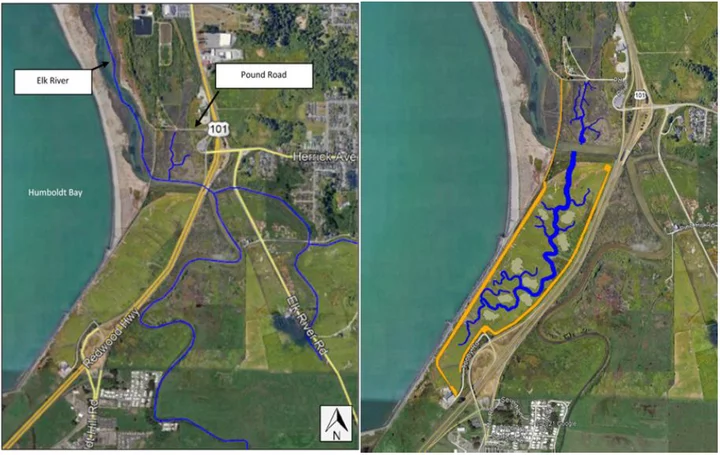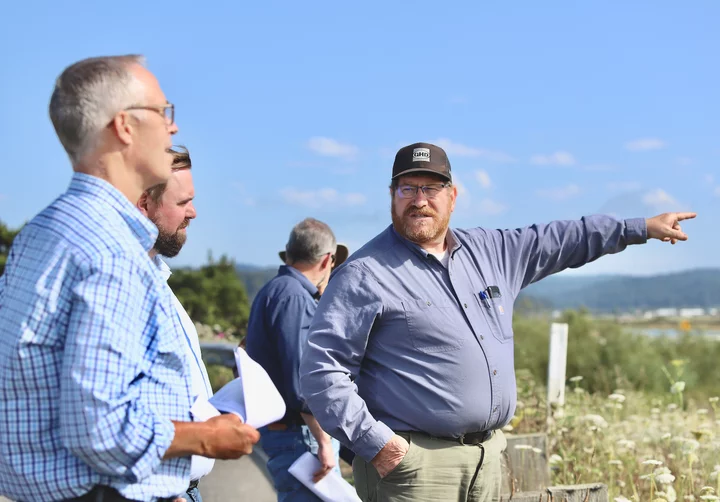
GHD Inc. Project Engineer Patrick (right) describes the ins and outs of the the Elk River Estuary Enhancement Project to Rep. Jared Huffman. | Photos by Andrew Goff
###
For the better part of a decade, the City of Eureka has been dreaming up a plan to rehabilitate and restore wetland habitat along Elk River Estuary on Humboldt Bay. The ambitious Elk River Estuary Enhancement Project, which broke ground earlier this summer, will open up a network of waterways connected to Elk River to improve fish passage and provide new opportunities for aquatic recreation.
Congressman Jared Huffman joined Eureka Mayor Susan Seaman, City Councilmembers Leslie Castellano and Natalie Arroyo, city staff, contractors and a couple of LoCO reporters on a walkabout of the project site during his Tour de Humboldt on Tuesday afternoon.

Existing project site vs. proposed inter-tidal channels. | Image via City of Eureka
The restoration project will enhance estuary and inter-tidal wetland habitat across nearly 115 acres of City-owned property between the Herrick and Humboldt Hill exits along the west side of Highway 101. Once the restoration work is complete, critters and humans alike will be able to enjoy 2.8 miles of navigable channels connected to the Elk River including a non-motorized boat launch, a one-mile extension to the Eureka Waterfront Trail and a new parking area at the Humboldt Hill exit.
Area 1 will encompass the north end of the project which seeks to restore 25 acres of saltwater marsh through the removal of 20 acres of invasive Spartina to create a channel network with varied marsh plains. Area 2 on the south side of Elk River will convert 89 acres of existing pasture into a salt marsh and inter-tidal channel network to reclaim the historic floodplain and provide capacity for king-tides and resilience to sea level rise.
“The goal is to remove all of those barriers for fish and aquatic, create a large full title regime here and actually deepen and widen these channels,” Project Manager Katie Marsolan explained ahead of Tuesday’s tour of the project site. “When we’re all done – after large amounts of Spartina removal, grading, earthwork and restoration – this restoration project will allow for a larger tidal cycle and create some resilience to sea level rise, as well as a larger basin for higher tides.”

Sullivan and Project Manager Katie Marsolan.
The City launched the concept development phase of the project in 2015. In the time since the City has conducted multiple environmental studies in accordance with the California Environmental Quality Act (CEQA) and partnered with the State Coastal Conservancy to secure more than $6 million in grant funding for the project. The City awarded a construction contract to Figas Construction earlier this year to perform earthwork, grading, water management, and trail construction. Construction began in June and will likely wrap up this fall. From there, the City will begin the revegetation process which – along with continued Spartina eradication – is expected to continue through 2024. Monitoring of the site will continue through 2027.
“We’re trying to plant different types of plants that are going to be successful in particular zones,” Patrick Sullivan, project engineer for GHD Inc., told the Outpost while traversing the project site’s dusty and rugged terrain in his truck. “One of the interesting aspects of our partnership with the Wiyot Tribe is [their Natural Resources director] Adam Canter is going to bring in native vegetation that is significant to the Tribe.”

Huffman looks on as Sullivan explains Spartina removal via Marsh Master®.

The Marsh Master® Amphibious Marsh Buggy trampling invasive Spartina.
Out on the project site, Sullivan explained how the network of earthen berms and channels will prevent inundation as the sea level rises. “But not necessarily in the way you’re thinking of keeping the tide from coming in,” he said. “It’s more a parking lot for stormwater to come down when we get those big surges during the King Tides of a storm event that might flood Highway 101.”
“Do King Tides already threaten the 101?” Huffman asked.
They do, Marsolan said. Even with drainages within the median, a high tide event could result in localized flooding on the highway. “We’re working with Caltrans to check in on their infrastructure while we’re out here to make sure everything is working properly.”
“And do you think that baby salmonids are going to come down here and love it and get fat?” Huffman asked.
“I think it’s gonna provide some refuge, but I do think this is going to be high turbidity so we’re not sure it’s necessarily rearing habitat,” Marsolan said.
Even still, Sullivan said his team found a few coho salmon while removing the tide gate. “So, maybe not focused on rearing but I’ll bet you lunch they’ll be here,” he said.
The tour ended with a quick jaunt over to a very foggy Stinky Beach, where Huffman congratulated the City for taking on such an immense project and said he looked forward to checking it out after completion.
“The project really shows that the City of Eureka was thinking ahead about how to meet some of the challenges of sea level rise while working to revive some of the reclaimed marshes of Humboldt Bay,” he said. “Pairing restoration and recreation is also a great idea. I’m looking forward to seeing how the project develops over the coming years.”
Scroll for more pictures of Tuesday’s tour.
###

Ella, canine security detail, poses with Bob and Adam Figas of Figas Construction.

Figas’, meet Huff!

Wow! That’s a big ditch!

Smile! Huffman poses with City officials, staff, stakeholders and contractors.
CLICK TO MANAGE